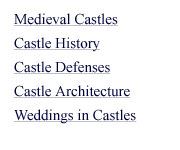|
Castle Defenses
Castle Defense Architecture
The medieval castle was used as a weapon
unto itself and its defending garrison of soldiers exploited
every possible advantage. The castle's main weapon was obvious
in its medieval architecture. Stone curtain walls that were
constructed anywhere between 20 and 40 feet high and 7 to
20 feet thick were made more formidable with protecting. Curtain
walls were raised even higher as improvements were made in
medieval siege engines, but enemy miners could then attack
the castle's foundation.
Medieval engineers were used during castle
construction to design the stronghold to better prevent attacks
from any blind angles or potential flanking positions. Attacking
armies liked cover, so the surrounding land near the castle
would often be cleared, and vulnerable approaches would be
heavily fortified.
Most castles had unique designs and exploited
their natural surroundings, and most Middle Age fortifications
used a variety of architecture devices to improve their defense.
Towers were often the last section
of a castle to fall during an attack, and defending garrisons
protected them at all cost. Medieval castle towers came in
several shapes: circular, semi-circular, and square. In addition
to being prime lookout posts and firing positions for archers,
these towers were used in other capacities, such as storehouses
and prisons. Medieval towers were often constructed to include
merlons, which are hollow spaces through which archers could
fire arrows. Other weapons of choice included stones and Greek
fire (which was a generic name for any burning liquid made
from molten metal or oil), all of which could also be dropped
on attackers. Returning crusaders brought back designs influenced
by Moorish architecture, and by the late 1100s towers incorporated
curved, Arab-like features. This curved architecture made
it more difficult for miners to sabotage the foundation.
Castle moats could either be wet
or dry. There were times when the unavailability of water
or persistent droughts forced castle architects to build dry
moats. Moats were used defensively from the earliest medieval
castles throughout the Middle Ages. Using strategic moats
were often the castle's first way of defending against an
attacking army.
The castle's most vulnerable point was
often the front door. Portcullises and castle drawbridges
were used to provide defense. Made almost exclusively of wood,
drawbridges could be removed by hand before an attack or pulled
up by soldiers using either ropes or chains.
Gatehouses were impressive, and
often rose several stories high. They also contained both
living quarters for soldiers and the devices that controlled
heavy, protective, grilled gates called portcullises. These
sliding doors were usually made of thick timber, and when
available, covered with some kind of iron plating. Defending
armies were able to shoot arrows through the holes. Larger
castles might feature several of these doors that would be
used to trap attacking soldiers in narrow, winding hallways.
From atop these passageways, the defending army would be poised
to drop stones or Greek Fire, and launch arrows through hard
to see "murder holes" carved in the ceiling.
|










